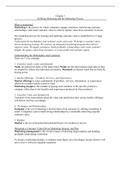Chapter 1
Defining Marketing and the Marketing Process
What is marketing?
Marketing is the process by which companies engage customers, build strong customer
relationships, and create customer value in order to capture value from customers in return.
The marketing process for creating and capturing customer value is simplified in a 5 stage
process:
Understand the marketplace and customer needs and wants design a customer value-
driven marketing strategy construct an integrated marketing program that delivers
superior value engage customers, build profitable relationships, and create customer
delight capture value from customers to create profit and customer equity.
Understanding the Marketplace and Customers
There are 5 core concepts.
1. Customer needs, wants and demands.
Needs are defined as states of felt deprivation. Wants are the form human needs take as they
are shaped by culture and individual personality. Demands are human wants that are back by
buying power.
2. Market Offerings – Products, Services, and Experiences.
Market offerings is some combination of products, services, information, or experiences
offered to a market satisfy a need or want.
Marketing myopia is the mistake of paying more attention to the specific products a
company offers than to the benefits and experiences produced by these products.
3. Customer Value and Satisfaction.
Customers form expectations about the value and satisfaction that various market offerings
will deliver and buy accordingly.
4. Exchanges and Relationships
Exchange is the act of obtaining a desired object from someone by offering something in
return. Companies want to build strong relationships by consistently delivering superior
customer value.
5. Markets
Market is the set of all actual and potential buyers of a product or service.
Designing a Customer Value-Driven Marketing Strategy and Plan
Marketing management is the art and science of choosing target markets and building
profitable relationships with them.
To design a marketing strategy, a company must figure out a few things: decide whom it will
serve, how it will serve targeted customers.
, There are five concepts under which organizations design and carry out their marketing
strategies:
Production concept: the idea that consumers will favor products that are available
and highly affordable; therefore, the organization should focus on improving
production and distribution efficiency.
Product concept: idea that consumers will favor products that offer the most quality,
performance, and features: therefore, the organization should devote its energy to
making continuous product improvements.
Selling concept: the idea that consumes will not buy enough of the firm’s products
unless the firm undertakes a large-scale selling and promotion effort.
Marketing concept: a philosophy in which achieving organizational goals depend on
knowing the needs and wants of target markets and delivering the desired satisfactions
better than competitors do.
Societal marketing concept: the idea that a company’s marketing decisions should
consider consumers’ wants, the company’s requirements, consumers’ long-run
interests, and society’s long-run interests.
Next, the marketer develops an integrated marketing program that will actually deliver the
intended value to target customers.
Managing Customer Relationships and Capturing Customer Value
Customer relationship management is the overall process of building and maintaining
profitable customer relationships by delivering superior customer value and satisfaction.
The key to building lasting customer relationships is to create superior customer value and
satisfaction.
A customer buys from the firm that offers the highest customer-perceived value – the
customer’s evaluation of the difference between all the benefits and all the costs of a market
offering relative to those of competing offers.
Customer satisfaction is the extent to which a product’s perceived performance matches a
buyer’s expectations.
Companies can build customer relationships at many levels, depending on the nature of the
target market. Today, almost every brand has a loyalty reward program.
Customer-engagement marketing is making the brand a meaningful part of consumers’
conversations and lives by fostering direct and continuous customer involvement in shaping
brand conversations, experiences, and community.
Customer brand advocacy are actions by which satisfied customers initiate favorable
interactions with others about a brand.
One form of customer-engagement marketing is consumer-generated marketing: brand
exchanges created by consumers themselves – both invited and uninvited – by which
consumers are playing an increasing role in shaping their own brand experiences and those of
other consumers.
Partner relationship management is working closely with partners in other company
departments and outside the company to jointly bring greater value to customers.





